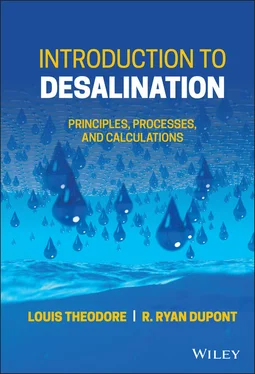Sea level – The surface of the sea that is employed as a reference for elevation.
Seawall – A coastal wall built to provide protection against erosion and/or flooding from the ocean.
Seawater intrusion – The movement of seawater into freshwater aquifers near the coast when these freshwater aquifers are over pumped.
Secondary drinking water regulation – A regulation that sets a maximum acceptable level for contaminants that adversely affect the taste, odor or appearance of water or otherwise adversely affect the public welfare.
Sediment – The solid material or deposits that have settled from a fluid.
Sedimentation tank – A tank in which water or wastewater containing settleable solids is retained for a period of hours to allow these solids to move to the bottom of the tank by gravity; the settled solids are removed from the bottom and the floating solids are skimmed off the top for further treatment and disposal; also called clarifiers. See also Settling tank.
Semiconfined aquifer – An aquifer that is partially confined by a layer (or layers) of low permeability soil or rock through which recharge and discharge nevertheless may occur.
Semipermeable membrane – A membrane that allows substances of a certain size to pass through it while preventing the passage of larger ones.
Settleable solids – The materials that are of sufficient size and density to sink to the bottom of a sedimentation tank.
Settling tank – A tank used in water and wastewater treatment to hold water for a period of hours, during which heavier particles sink to the bottom for removal, treatment, and disposal; also called a clarifier. See also Sedimentation tank.
Sewage – The wastewater produced by residential, commercial, institutional, and industrial facilities.
Sewer – The system of pipes or conduits employed to collect and deliver wastewater to treatment plants or storm water surface water bodies.
Shore – The land bordering any body of water.
Slow sand filtration – A treatment process that involves the passage of raw water through a bed of sand at low velocity which results in the substantial removal of chemical and biological contaminants through the development of a biolayer (schmutzdecke) at the sand surface.
Sludge – The thick, semisolid waste that accumulates as a result of the chemical coagulation, flocculation, and settling which occurs during drinking water treatment; the thick, semisolid biomass that is produced in the biological treatment of wastewater.
Sludge cake – The dewatered sludge from a treatment plant that has a solids content of 18 to 30% solids.
Sludge dewatering – The process of removing water from sludge using methods such as air drying, pressure filtration, vacuum filtration, centrifugation, or belt presses.
Sludge dryer – A mechanical device for the removal of a large percentage of moisture from sludge by heat.
Sludge filter – Mechanical devices in which wet sludge, usually conditioned by a coagulant, is dewatered by means of vacuum (vacuum filter) or elevated pressure (pressure filter).
Slurry –A high solids content mixture of particulate matter and liquid.
Sodium chloride (NaCl) – A colorless, transparent, crystalline solid or white, crystalline powder; it is noncombustible.
Soft water – A water with a low concentration of divalent, primarily calcium and magnesium, cations.
Softening – The chemical precipitation of divalent cations which cause the hardness of water; chemical coagulants, alum or ferric chloride, are normally used as coagulants, with flocculation and sedimentation following coagulant addition.
Soil drainage – The removal of excess water from a soil by gravity.
Soil moisture – Water content in the soil, generally given as volume or weight percent.
Solubility – The ability of one substance to be dissolved by another.
Spray irrigation – The application of water to a land surface via spray droplet application.
Steam drum – A vessel in a boiler in which the saturated steam is separated from the steam–water mixture and into which the feedwater is introduced.
Still – An apparatus to purify liquids through heating to selectively boil and then cool to condense the vapor (e.g. to prepare alcoholic beverages, distilled water, etc.).
Storm drain – A drain employed for conveying storm water runoff to a sewer.
Storm sewer – A piping system employed exclusively for the transport of stormwater from streets, buildings, and surface runoff.
Stormwater runoff – The portion of the volume of a rainfall event that exceeds the infiltration and storage capacity of a watershed.
Subterranean water – The water that occurs in open spaces within rock materials of the Earth’s crust.
Superheated steam – Steam at a temperature above its boiling point at a given pressure.
Supersaturation – An unstable condition in which a solvent contains more dissolved matter or gas than is present in a saturated solution of the same components at an equivalent temperature.
Surface water – All water that is above the surface of the ground and is naturally open to the atmosphere.
Surge irrigation – The intermittent application of water to irrigation pathways; this method pulses water down the furrow and creates more uniform irrigation water distribution.
Suspension – A system in which very small particles are uniformly dispersed in a liquid or gaseous medium.
Tank – A stationary device that is essentially a container, e.g. designed to contain an accumulation of waste or liquid, that is constructed primarily of non-earthen materials which provide structural support.
Temperature gradient – The change in temperature with distance or position.
Tertiary treatment – The advanced treatment of wastewater beyond secondary treatment; it may involve combinations of physical, chemical, and biological treatment processes to remove solids, nutrients, metals, salts, nonbiodegradable organics, etc. to prepare the waste for disposal into highly sensitive environments or for reuse.
Thickener – A small circular or rectangular sedimentation tank, designed to increase the concentration of solids in a suspension.
Thickening agent – Any of a variety of substances employed to increase the viscosity of liquid mixtures and solutions without changing its other properties.
Tidal wave – An exceptionally large wave, tsunami, or increase in the water level along a shore due to strong winds, volcanic eruption, or earthquake.
Tide – The periodic rising and falling of water that results from the gravitational attraction of the moon and sun acting on the rotating Earth.
Total organic carbon (TOC) – The total amount of organic carbon present in water as organic compounds (e.g. amino acids, hydrocarbons, proteins, etc.).
Toilet displacement device – Object placed in a toilet tank to reduce the amount of water used per flush; for example, weighted plastic jugs filled with water or toilet dams that hold back a reservoir of water when the toilet is flushing.
Toxic – A term used to describe a poisonous substance that has a harmful effect on an organism by ingestion, inhalation, or skin absorption.
Trace – A very small quantity of a constituent, the amount of which cannot be determined precisely because of its low concentration.
Transpiration – The process by which water passes through living organisms, primarily plants, and into the atmosphere.
Treatment – Any method, technique, or process that is designed to change the physical, chemical, and/or biological composition of a waste so as to neutralize it, recover energy or material resources from it, render it nonhazardous or less hazardous, or make it safer to transport, store, reuse, or dispose of.
Читать дальше












